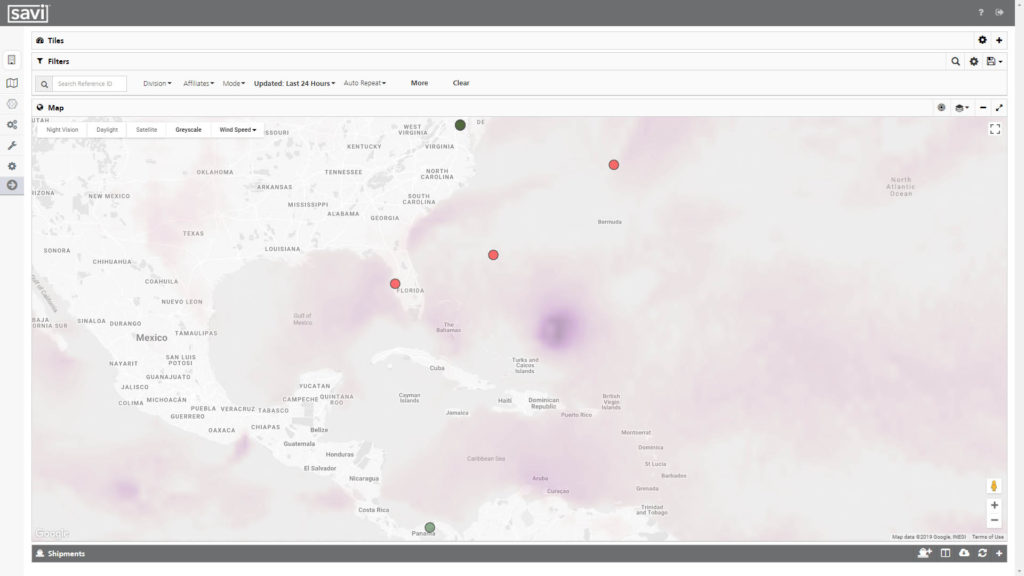When it rains, it pours. With the 2020 hurricane season beginning while supply chains worldwide are still dealing with widespread disruptions from the coronavirus pandemic, that old saying feels particularly relevant right now.
And this hurricane season could be a challenging one. The National Oceanic and Atmospheric Administration (NOAA) predicts that there is a 60% chance the 2020 hurricane season will have “above-normal” activity. NOAA expects 13-19 named storms, with 6-10 becoming hurricanes.
Companies now face a combined challenge of resuming operations following COVID-19 shutdowns while simultaneously preparing for potential short, sharp disruptions from a hurricane. Here’s how real-time, in-transit visibility can help you monitor shipments to reduce supply chain risks when the next hurricane happens.
Mitigate Hurricane Delays in Your Supply Chain with Real-Time Shipment Visibility
When a Hurricane Happens, Supply Chain Disruption Follows – Especially in a COVID19 World
Hurricane season always presents the possibility for supply chain disruption. According to a report from Resilience360 and Riskpulse:
“Data indicates that in the event of an approaching tropical storm, ports in the Caribbean, Gulf of Mexico, and the east coast of the U.S. usually suspend cargo operations for an average of 9 days while the ports in the Pacific and the Indian Ocean normally close for an average of 1-3 days and 1-2 days respectively.”
Due to the pandemic, there have been a large number of blank sailings in 2020, making things difficult for firms trying to move ocean freight.
Meanwhile, air freight has also been strained. JOC reports that air cargo rates are likely to “remain at historically high levels through the summer, supported by disrupted supply chains as manufacturing restarts and reduced capacity for ocean transport because of extensive blank sailings.”
Shippers face a number of challenges across transportation modes already as a result of the coronavirus pandemic. If and when a serious storm happens year, it will further disrupt logistics as vessels are halted, as they were in 2019 while Hurricane Dorian battered the Southeastern U.S.
This image from Savi Visibility shows Hurricane Dorian making landfall with the southeastern United States in 2019. Big storm, big impact on shipping.
Any time a hurricane’s storm path brings it close to land, it can have a big impact on ocean shipping, forcing ports to close and causing congestion at other hubs. Trucking hours could be reduced, and planes may be grounded. All these issues mean your shipments could face lengthy delays.
Why Real-Time Shipment Location Matters for Storm Response
When a tropical storm or hurricane forms, knowing where your shipments are in relation to the storm is pretty important. A storm-related delay could create serious issues.
If you are a pharmaceutical manufacturer, for example, what is the new ETA for your shipment to arrive at the distribution center? Will that ETA allow you to meet customer-critical hospital orders in time?
What if a storm delay breaks the cold chain? You could lose millions of dollars’ worth of temperature-sensitive ingredients or medicines if you can’t re-route an at-risk shipment.
Here’s another example: let’s say you’re shipping chemicals, and your container is delayed or diverted because of bad weather closing the original destination port. Will there be storage tanks available when your container does arrive? You need an accurate, real-time ETA to be able to decide if you can continue to your original destination or if you will need to find an alternative port.
Having a real-time snapshot of where your shipments are and continuously updating ETAs is vital when a major supply chain disruption like a hurricane happens. When you need a precise location to make a feasible Plan B for your shipment, the latent information milestone reporting offers is of little value. Being able to monitor your shipment’s location in real time to know when it will actually arrive is crucial.
Real-time response has become an expectation in supply chain management. Without the proper tools to provide end-to-end in-transit visibility, your business cannot compete.
This piece was originally published in August 2019. It has been updated for clarity and content.


